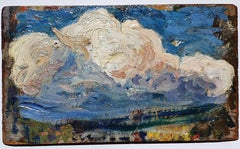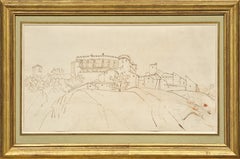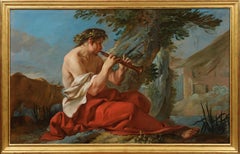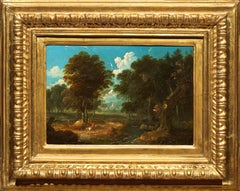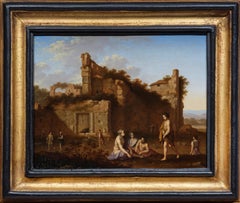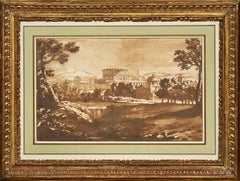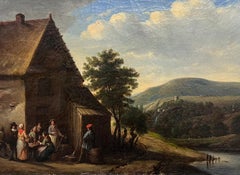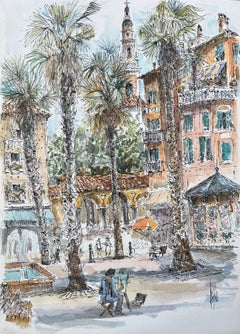Stephane Renard Fine Art Landscape Paintings
to
8
4
1
1
Overall Width
to
Overall Height
to
9
4
1
1
4
10
1
1
14
7
3
3
2
2
1
1
1
1
10
7
4
4
3
1
1
1
1
1
11
14
Two Studies of Clouds, a double-sided oil on panel by Henri Martin (ca. 1886)
By Henri Martin
Located in PARIS, FR
This rare double-sided oil on panel, probably painted during the summer of 1886, is an interesting testimony to the artist's style development. It present two complementary paintings...
Category
1880s Post-Impressionist Landscape Paintings
Materials
Oil, Wood Panel
View of a Mansion in the South of France, a drawing by Claude-Joseph Vernet
By Claude-Joseph Vernet
Located in PARIS, FR
We would like to thank Madame Beck-Saiello for confirming the autograph nature of this drawing after an in-person examination.
It was probably during an excursion in the countryside near Avignon that Claude-Joseph Vernet executed this drawing, enhanced with pen and brown ink, depicting a mansion on a hilltop overlooking a small village with geometric shapes.
1. Joseph Vernet, a painter influenced by Italy
Claude-Joseph Vernet was born in Avignon in 1714, the son of Antoine Vernet (1689-1753), an artisan painter of architectural decorations, coach panels, and the like. He moved to the studio of Philippe Sauvan (1697-1792), a leading history painter in Avignon, and then worked with Jacques Viali (active 1681-1745), a decorative, landscape, and marine painter in Aix-en-Provence. Vernet's first recorded paintings were decorative overdoors executed in 1731 in the Aix townhouse of the marquise de Simiane. In 1734, Joseph de Seytres, marquis de Caumont, a leading amateur in Avignon, sponsored Vernet to make a study trip to Italy to complete his artistic education and to draw antiquities for his patron.
As Avignon was a papal territory in Vernet's day, he also had a number of useful introductions among influential churchmen when he arrived in Rome. Vernet was soon at home in the French community there, and he was encouraged by Nicolas Vleughels (1668-1737), director of the Académie de France in Rome, even though the young painter had no official affiliation with the royal institution. He likely entered the studio of the French marine painter Adrien Manglard...
Category
1730s Old Masters Landscape Drawings and Watercolors
Materials
Ink, Laid Paper, Pen, Carbon Pencil
Mercury and Io, a rediscovered painting by Jean-Baptiste Marie Pierre (ca. 1740)
Located in PARIS, FR
We would like to thank Mr. Nicolas Lesur for confirming the autograph nature of the entire composition after a direct examination of the painting on November 27, 2024.
This painting...
Category
1740s Old Masters Figurative Paintings
Materials
Canvas, Oil
Stag Hunting in the Vicinity of Nuremberg by a German Artist Peter von Bemmel
Located in PARIS, FR
This small landscape shows a hunting scene: two riders are chasing a stag with their dogs at the edge of a forest. Signed by Peter von Bemmel, it is typical of the production of this...
Category
1720s Old Masters Landscape Paintings
Materials
Copper
Gathering in antique Ruins, a monogrammed painting by Jan van Haensbergen
By Jan Van Haensbergen
Located in PARIS, FR
Jan van Haensbergen was a painter of the Dutch Golden Age and a pupil of Cornelius van Poelenburgh (Utrecht 1594 - 1667). The painting we are presenting is inspired by Poelenburgh’s landscapes from his Italian sojourn. The dreamlike atmosphere of this Gathering in antique ruins appealed to us. Against a backdrop of antique ruins, three draped characters (perhaps bathers) are sitting in a circle, greeting a fourth character walking towards them.
Their tranquility contrasts with the bustle of the other characters in the background. They constitute a vivid illustration of otium, this leisure time that allows us to realize our full potential. With this Arcadian landscape, Jan van Haensbergen invites us in turn to leave the hustle and bustle of everyday life behind, to take a break, to enjoy the present moment chatting with close friends…
1. Jan van Haensbergen, a landscape and portrait painter of the Dutch Golden Age
Jan van Haensbergen was born in 1642 in Gorinchem, a town in southern Holland to the east of Rotterdam. He was a pupil of Cornelius van Poelenburgh, and began by painting landscapes inspired by those of his master, in an Italianate style. Between 1668 and 1669, he was registered at the Guild of Saint Luke in Utrecht.
In 1669, he moved to The Hague, where he joined the Confrérie Pictura, an artist society founded in 1656. His portraits, which became his main activity as a painter after settling in The Hague, were strongly influenced by Caspar Netscher (Prague or Heidelberg 1639 - The Hague 1684), whom he met in The Hague and whose son Constantijn became his son-in-law by marrying his daughter Magdalena.
In addition to his work as an artist, Van Haensbergen was also an art dealer, probably helped by his appointment as Dean of the Confrérie Pictura, where he also teached.
2. Description of the artwork and related paintings
This painting seems to us to be a kind of allegory of otium, that quiet bliss promised by Epicurus. It might even evoke an Epicurean proverb: "It is better to lie on the naked ground and be at ease, than to have a golden carriage and a rich table and be worried" .
Three draped young people - two men and a woman in the background - are seated in a circle, greeting a fourth figure walking towards them, hair disheveled and body draped in a towel as if drying off after a bath, indicating the need for prior purification to fully enjoy this rest. Their nonchalance contrasts with the bustle of the various characters in the background.
The composition is punctuated by successive diagonals, and opens onto a landscape on the right, with a succession of mountainous planes. This painting is typical of the Italianate works produced by Van Haensbergen in the 1660s under the influence of Cornelis van Poelenburgh...
Category
17th Century Old Masters Landscape Paintings
Materials
Oak, Oil
View of an Antique City, a wash landscape by Jan de Bisschop (1628 - 1671)
Located in PARIS, FR
The attribution to Jan de Bisschop has been confirmed by the RKD with the following comment: "We base this attribution on the dark washes, the subject represented and the monogram".
...
Category
17th Century Old Masters Landscape Drawings and Watercolors
Materials
Ink, Pen
View of Piazza San Marco, a tempera signed by Giacomo Guardi (1764 - 1835)
Located in PARIS, FR
Signed and localized on the verso :
"Vedute di parte dalla Piazza dif.a alla Loggetta e cam
panil parte della Zecca ed in lontan Proc.e vechie e parte della chiesa
punto preso vic...
Category
Early 19th Century Old Masters Landscape Drawings and Watercolors
Materials
Tempera
River Landscape with Shepherds and Architecture, a painting by Jan van Bunnik
By Jan van Bunnik
Located in PARIS, FR
This painting has been the subject of a study by the art historian Fabrizio Dassie (available on request), confirming its inclusion in Jan van Bunnik’s corpus.
In this painting, Ja...
Category
Late 17th Century Old Masters Landscape Paintings
Materials
Copper
View of the Ovo Castle in the Moonlight, a 19th century Neapolitan gouache
Located in PARIS, FR
Neapolitan gouaches appeared in the eighteenth century when tourism in the Naples area was developing: the discoveries of Herculaneum and Pompeii made this city a mandatory stop on the Grand Tour, the journey made by wealthy Europeans to complete their education.
Generally small in size for ease of transport and affordable in price, these gouaches were the ideal travel souvenir that these tourists of the early days were bringing back to capture the idyllic landscapes they had discovered during their journey and to share them with family and friends upon their return at home.
The Bay of Naples and the eruptions of Vesuvius are the favourite themes of these views. Here we have a view of the Ovo Castle, which was rebuilt on the island of Partenope, in the middle of the Bay of Naples and about a hundred metres from the shore by the Normans in the 12th century on antique ruins...
Category
Early 19th Century Romantic Landscape Drawings and Watercolors
Materials
Gouache, Paper
Landscape with Trees and a Fisherman walking, a drawing by Jan Van Goyen
By Jan Josefsz Van Goyen
Located in PARIS, FR
No Dutch draughtsman ever captured the atmosphere of the rural countryside of Holland with the same atmospheric and engaging simplicity that Van Goyen achieved in drawings such as this. Indeed, his landscapes were seminal in the development of the genre. The present sketch conveys a striking sense of movement within the natural landscape, conveyed by the deftly applied strokes of chalk, from which the artist’s hand can be sensed. The composition is characteristic of his work, with the low horizon affording significance to the broad sky and the soaring birds within. This feeling of windswept motion powerfully evokes the expansive Dutch farmland with which he was evidently preoccupied.
1. Jan van Goyen...
Category
1650s Old Masters Landscape Drawings and Watercolors
Materials
Chalk, Ink, Laid Paper
View of Ariccia, a preparatory drawing by Achille Bénouville (1815 - 1891)
Located in PARIS, FR
This very modern drawing presents a view of Ariccia, a small town 25 kilometres south-east of Rome. The Palazzo Chigi (in which the film-maker Luchino Visconti would film a large part of The Leopard a century later) and the adjoining church are seen from the bottom of the ravine that surrounds the town. This drawing is a moving testimony to the attraction of the city for artists of the Romantic period, who established in Ariccia a vivid artists' colony.
1. Achille Bénouville...
Category
1850s Romantic Landscape Drawings and Watercolors
Materials
Ink, Gouache, Pencil
Study for « Paysage de Fribourg » - 1943 a drawing by Balthus (1908 - 2001)
By Balthus (Balthasar Klossowski de Rola)
Located in PARIS, FR
Provenance: Frédérique Tison, Château de Chassy (Burgundy-Franche Comté - France)
Bibliography: J. Clair, V. Monnier Balthus, catalogue raisonné of the complete works, Gallimard, Pa...
Category
1940s Modern Landscape Drawings and Watercolors
Materials
Paper, Pencil
Italian Landscape with Jack Players, a painting by Gaspard Dughet (1615 - 1675)
By Gaspard Dughet
Located in PARIS, FR
Here Gaspard Dughet offers us an idyllic vision of the Roman countryside. The stages follow one another in a perfectly structured composition, revealing here a lake, there travellers walking along, gradually leading our eye to the blue horizon. But behind its classical composition, this landscape is particularly interesting because of three anthropomorphic details that the artist has hidden, opening the way to a radically different interpretation...
1. Gaspard Dughet, a landscape artist in the light of Poussin
Gaspard Dughet was born on June 4th, 1615 in Rome where his father, of French origin, was a pastry cook. He was probably named Gaspard in honour of his godfather Baron Gaspard de Morant, who was, or may have been, his father's employer. His older sister Jeanne married the painter Nicolas Poussin (1594 - 1655) on September 1st, 1630. The young Gaspard was apprenticed with his brother-in-law at the beginning of 1631, which led his entourage to name him Gaspard Poussin. The first preserved works of the painter date from the years 1633-1634 and were painted in Poussin’s studio.
Around 1635, Gaspard Dughet became emancipated and began to frequent the Bamboccianti circle. In 1636, he became friends with the painter Jean Miel (1599 - 1656), but also with Pier Francesco Mola (1612 - 1666) and Pietro da Cortona (1596 - 1669).
This was also the time of his first trips throughout Italy. The painter, although of French origin, appears never to have visited France. In 1646 he settled permanently in Rome. A recognized painter with a solid book of orders, he remained faithful to landscape painting throughout his life, alternating between cabinet paintings and large decorative commissions, using both oil and fresco.
Nailed to his bed by rheumatic fever at the age of 58, he died on May 25, 1675.
2. Discovering an idealized landscape
Beyond a relatively dark foreground that takes us into the landscape, we discover a vast bluish horizon: a plateau surrounded by deep ravines advances to the right, overhanging an expanse of water that sparkles below. A road winds through a mountainous mass as if leading us to the fortress that crowns it; another town appears in the distance at the foot of three conical mountains.
The composition is rigorous, mineral, and structured by geometric volumes. The various stages in the landscape lead one to the next attracting the eye towards the horizon located in the middle of the canvas. The general impression is that of a welcoming and serene nature.
In many places the paint layer has shrunk, or become transparent, revealing the dark red preparation with which the canvas was covered and accentuating the contrasts.
Human presence is limited to three jack players, leaning against a mound in the foreground. Their long garments, which may evoke Roman togas, contribute to the timelessness of the scene.
Close examination of the canvas reveals two other travellers on the path winding between the rocks. Made tiny by the distance, their introduction in the middle register, typical of Dughet's art, lengthens the perspective.
While it is difficult to date the work of a painter who devoted his entire life to the representation of landscapes, it is certain that this painting is a work from his later years. The trees that occupied the foreground of his youthful compositions have been relegated to the sides, a stretch of water separates us from the arid mountains counterbalanced by two trees represented on the opposite bank. The introduction of this stretch of water in the middle of the landscape betrays the influence of the Bolognese and in particular of the Dominiquin (1581 - 1641)
A number of similarities with a drawing in the British Museum might suggest a date around 1656-1657, since, according to Marie-Nicole Boisclair , it has been compared with the Prado's Landscape with the Repentant Magdalene, painted at that period.
3. Three amazing anthropomorphic details
While some late Renaissance landscapes offer a radical double reading, allowing one to see both a face or a human body behind the representation of a landscape, it seems interesting to us to hypothesize that Gaspard Dughet had fun here by slipping in a few details that, taken in isolation, evoke human or animal figures.
We will give three examples, looking closely at a cloud, the trunk of a broken tree and the top of a cliff.
The main cloud could thus evoke a Christ-like face or that of an antique god...
Category
1650s Old Masters Landscape Paintings
Materials
Oil
Macbeth and the Three Witches a Painting on Panel by Francesco Zuccarelli
By Francesco Zuccarelli
Located in PARIS, FR
This painting, created during Zuccarelli's stay in England, represents the decisive moment when Macbeth, together with Banquo, meets the three witches who announce that he will be Ki...
Category
1760s Old Masters Landscape Paintings
Materials
Oil, Wood Panel
Related Items
Figures Chatting outside Village Tavern in Mountain Landscape, Period Oil
By 19th century Dutch or Flemish school
Located in Cirencester, Gloucestershire
Dutch/ Flemish School, early 1800's
oil on canvas, framed
framed: 19 x 24 inches
canvas: 13.5 x 18.5 inches
provenance: private collection, France
condition: good and sound condition...
Category
Early 19th Century Old Masters Landscape Paintings
Materials
Oil, Canvas
$1,239 Sale Price
30% Off
H 19 in W 24 in
French Watercolor of Vibrant Square with Painter, Palm Trees, and Architecture
Located in Cirencester, Gloucestershire
Title: French Watercolor of Vibrant Square with Painter, Palm Trees, and Architecture
by Robert Lepine (French, 1929 - 2017)
Signed: Yes
Medium: Watercolor painting on artists paper
...
Category
Late 20th Century French School Landscape Drawings and Watercolors
Materials
Pen, Watercolor
$497 Sale Price
53% Off
H 14.25 in W 10.25 in D 1 in
Naval Battle Engagement at Sea Large Busy Battle Scene Many Ships, Signed Oil
Located in Cirencester, Gloucestershire
English School, early 20th century
signed
oil painting on canvas, unframed
canvas: 17 x 24 inches
provenance: private collection, Eng;and
condition: good and sound condition, minor ...
Category
Early 20th Century Old Masters Landscape Paintings
Materials
Oil, Canvas
$1,351 Sale Price
30% Off
H 17 in W 24 in
Nude with Tree at El Capitan - Yosemite Mid Century Figurative Landscape
By Margaret Wherry Ziegler
Located in Soquel, CA
Mid century figurative landscape of a nude female figure with tree at El Capitan, Yosemite, California by Margaret Wherry Ziegler (American, 1909-1989). Signed "M. Ziegler" lower right. Displayed in a rustic new silver gilt frame. Image, 24"H x 12"W.
Margaret Wherry Ziegler was born in Cincinnati, Ohio on November 27, 1909. At a young age she traveled with her parents to the Philippines, Japan, India, Italy, Greece, and Europe.
She studied art at the Cincinnati Art Academy, Minneapolis Art Institute, the University of the Philippines, and the California College of Arts and Crafts. While in Japan she studied Japanese brush painting...
Category
1950s American Impressionist Nude Paintings
Materials
Oil, Illustration Board, Canvas
$2,000 Sale Price
20% Off
H 26.13 in W 14.13 in D 0.88 in
18th Century French Old Master Oil Painting Ancient Port Harbor Shipping Marine
Located in Cirencester, Gloucestershire
Harbor Scene
Circle of Claude Joseph Vernet (French, 1714-1789)
oil painting on canvas, framed in antique gilt frame
framed: 20.5 x 25.5
canvas: 19 x 23.5 inches
condition: very good...
Category
18th Century Old Masters Landscape Paintings
Materials
Oil, Canvas
$2,848 Sale Price
30% Off
H 20.5 in W 25.5 in
The Knight - painting - XVII century
Located in Roma, IT
The Knight is an original oil painting on canvas realized during the XVII century by an anonymous artist.
Provenance: Pecci-Blunt collection. Good condition...
Category
17th Century Old Masters Figurative Paintings
Materials
Canvas, Oil
Figures in Winter Dutch Snow Landscape Large 19th Century Oil on Canvas Painting
Located in Cirencester, Gloucestershire
The Winter Landscape
Dutch School, 19th century
oil painting on canvas, framed
framed: 22 x 28 inches
canvas: 16.5 x 23 inches
provenance: private collection, UK
condition: very goo...
Category
19th Century Old Masters Landscape Paintings
Materials
Oil, Canvas
$1,531 Sale Price
30% Off
H 22 in W 28 in
Large 18th Century British Old Master Oil Painting Figures at Dusk in Woodland
Located in Cirencester, Gloucestershire
The Close of Day
English artist, second half 18th century
circle of Thomas Gainsborough (British 1727-1788)
oil on canvas, unframed
canvas: 24.5 x 29 inches
provenance: private colle...
Category
18th Century Old Masters Landscape Paintings
Materials
Oil, Canvas
$2,124 Sale Price
30% Off
H 24.5 in W 29 in
Hellenic Hypotenuse. Nudes among Greek Columns. Mid-Century Surrealism
By Walter Charles Klett
Located in Miami, FL
Klett was an in-demand illustrator in the post-war period of the late 1940's and 1950's. and . His work appeared in many of the newsstand magazines at the time.
This work is a pers...
Category
1940s Surrealist Nude Paintings
Materials
Masonite, Oil
Landscape Near Felday, Surrey
By Abraham Hulk the Younger
Located in Hillsborough, NC
Dutch/English artist Abraham Hulk the Younger (1851-1922) is most known for landscapes of the British countryside. This work is one of a pair (the second work is also available by s...
Category
Late 19th Century Old Masters Landscape Paintings
Materials
Canvas, Oil
$2,240 Sale Price
20% Off
H 27 in W 22.75 in D 2.13 in
Antique American Early 1900s Nude Women & Swans Deco River Landscape Painting
Located in Buffalo, NY
Antique American impressionist nude women landscape oil painting. Oil on canvas. Framed. Signed "Wolfe". In excellent original condition. Handsomely framed in a giltwood molding....
Category
1920s Impressionist Landscape Paintings
Materials
Oil, Canvas
$875
H 20 in W 18 in D 2 in
Abraham and the Sacrifice of His Son Isaac by Adriaen Van Stalbemt, C. 1605-1610
Located in Stockholm, SE
Artist: Adriaen van Stalbemt (Stalbempt) 1580-1662
Title: Abraham and the Sacrifice of His Son Isaac “Das Opfer des Abraham”
According to the Old...
Category
Early 1600s Old Masters Landscape Paintings
Materials
Copper
